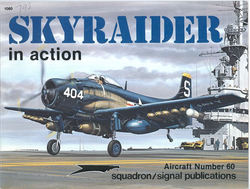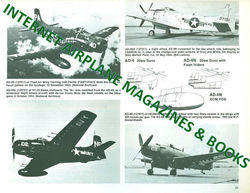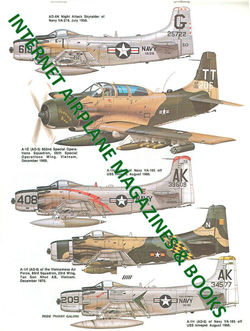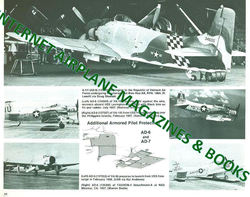SQUADRON SIGNAL DOUGLAS AD A-1 SKYRAIDER IN ACTION USN USMC USAF VNAF
AIRCRAFT NUMBER 60 BY JIM SULLIVAN. ILLUSTRATED BY DON GREER. 1983
KOREAN WAR USS VALLEY FORGE AD-4 SKYRAIDER VA-55 1952
NAS ATLANTA AD-4 SKYRAIDER
VA-115 USS PHILIPPINE SEA KOREAN WAR
INTRODUCTION (ED HEINEMANN, DOUGLAS XSB2D DESTROYER, MARTIN XBTM-1 MAULER, CURTISS XBT2C-1, KAISER FLEETWING XBTK-1, BOEIGN XF8B-1, DOUGLAS XBT2D-1 DAUNTLESS II)
AD-1 SKYRAIDER (CARBURATER INTAKE DETAILS, EXHAUST PIPE DETAILS, UNDER WING ATTACHMENT POINT DETAILS, VA-64 USS CORAL SEA, VA-20 NAS ALAMEDA, VA-4B USS FRANKLIN D. ROOSEVELT, VMAT-20 USMC MCAS EL TORO, AD-1Q VC-35 ECM, VC-33 NAS ATLANTIC CITY, VA-859 USS TARAWA, LANDING GEAR DETAILS, TAILWHEEL AND TAIL HOOK ARRANGEMENT DETAILS, VA-34 USS LEYTE, VA-702 USS BOXER, VF-152, AD-2 CANOPY)
AD-2 SKYRAIDER (EXHAUST DEVELOPMENT DETAILS, CANAOPY DEVELOPMENT DETAILS, AERIAL MAST DEVELOPMENT DETAILS, TAIL DEVELOPMENT DETAILS, FUSELAGE BOTTOM DIVE BRAKE DETAILS, AD-2 VA-155 NAS ALAMEDA, VMA-121 MCAS EL TORO, VA-65 NAAS SANTA ROSA CA USS BOXER)
US NAVY AIRCAFT CARRIER CRASH PHOTO GALLERY (USS VALLEY FORGE VA-155, VA-35 USS LEYTE
AD-3 SKYRAIDER (NATC PATUXENT RIVER, USS LEYTE VA-35, VA-923 USS BONHOMME RICHARD, VC-33 USS LEYTE, TAIL WHEEL DETAIL, COCKPIT DETAIL, VC-35 AD-3Q, AD-3W GUPPY USS BOXER, VX-1 NAS BOCA CHICA 1950, AD-3N NIGHTFIGHTER, AD-3S ASW VARIANT)
COLOR PROFILES (XBT2D-1 1945, AD-1 VA-4B USS FRANKLIN D. ROOSEVELT 1949, AD-3 VA-923 KOREA 1951 USS BONHOMME RICHARD, AD-3W MARINE HEDRON-2 MCAS CHERRY POINT 1951, AD-4 VA-194 USS VALLEY FORGE KOREA 1951, AD-4N VA-216 1956, USAF A-1E 56TH SPECIAL OPERATIONS WING SANDY CSAR VIETNAM 1969, A-1H AD-6 VA-165 USS INTREPID, A-1H AD-6 VIETNAMESE AIR FORCE VNAF 23RD WING TAN SON HUT AB 1970, A-1H AD-6 VA-165 USS INTREPID)
AD-4 SKYRAIDER (DETAIL BW PHOTO GALLERY INCLUDING WRIGHT R-3350-26WA ENGINE, COCKPIT, HVAR ROCKETS, GUNSIGHT, AD-4L DE ICER BOOT DETAILS, AD-4 VA-75 USS BONHOMME RICHARD, VA-728 USS ANTIETAM, AD-4Q CAG-102 USS BONHOMME RICHARD 1951, AD-4Q CVG-17 USS FRANKLIN D. ROOSEVELT, VMC-1 K-16 KOREA AD-4N 1954, FAWTUPAC AD-4N 1953, AD-4 20mm CANNON, 20mm CANNONS WITH FLASH HIDERS, AD-4N ECM POD)
AD-5 (A-1E) SKYRAIDER (CANOPY DEVELOPMENT DETAILS, VA-65 NAS ALAMEDA, PYLON DEVELOPMENT DETAILS, AD-5N VC-33 NIGHTHAWKS, VAASW-33 AD-5N, USS INDEPENDENCE VAW-33 A-1G, EA-1F VAW-10 NAS QUONSET POINT RI, A-1G AD-5 VAW-33 USS AMERICA 1967, AD-5W, AD-5S SEARCH LIGHT ECM POD AND PYLON MOUNT ASSEMBLY DETAIL)
AD-6 (A-1H) SKYRAIDER (VA-165 USS INTREPID VIETNAM 1966, VA-45 AD-6 USS INTREPID, VA-25 USS INDEPENDENCE, VMA-332 NAS MIAMI, USS FORRESTAL AD-6 VA-42, VNAF BIEN HOA 1964, ADDITIONAL ARMOURED PILOT PROTECTIOND ETAILS, VA-196 USS LEXINGTON 1957, VA-145 USS HORNET 1957, VA-96 USS KEARSARGE 1958, FASRON-4 NAS MIRAMAR 1957, VMA-225 NAS MIAMI, VMA-331 1959, VA-104 AD-6 USS LEYTE, VA-145 NAS MIRAMAR 1968, A-1H AD-6 VA-115 USS KITTY HAWK CV-63, VA-35 USS SARATOGA, A-1H 4407TH CCTS 1ST SOW HURLBURT FIELD, A-1H AD-6 USS CORAL SEA VA-25
AD-7 (A-1) SKYRAIDER (VA-95 USS RANGER, VA-145 A-1J 1966, COCKPIT INSTRUMENT PANEL DETAIL, VA-122 NAS LEMOORE, A-1J 1ST SPECIAL OPERATIONS SQUADRON USAF LAOS 1966, VA-145 USS CONSTELLATION CV-64)
A2D-1 SKYSHARK
Visit my Ebay Store to find more issues of KOKU FAN, AIRPOWER, WINGS, AIR CLASSICS, FINE SCALE MODELLER, SCALE AIRCRAFT MODELLER, SCALE AVIATION MODELLER INTERNATIONAL, AIRPLANE (ORBIS), WARPLANE (ORBIS), ILLUSTRATED ENCYCLOPEDIA OF AIRCRAFT, NAVAL AVIATION NEWS, AIR COMBAT, WAR MONTHLY, HISTORY OF THE SECOND WORLD WAR, COMBAT AIRCRAFT, AIR FAN, OSPREY AIRCRAFT OF THE ACES, AIRCRAFT PROFILE, SEA CLASSICS, AIR INTERNATIONAL, AIR ENTHUSIAST, ALL HANDS, FLYING, FLYPAST, AEROPLANE MONTHLY, RAF FLYING REVIEW, AIRCRAFT ILLUSTRATED, AIR EXTRA, TAKE OFF, THE ELITE, AIR FORCES MONTHLY, WAR MACHINE (ORBIS), MODEL AIRPLANE NEWS
-------------------------------------------------------------------------------------------------------------------
Additional Information from Internet
Encyclopedia
The Douglas
A-1 Skyraider (formerly AD)
was an American single-seat attack aircraft that saw service between the late
1940s and early 1980s. The Skyraider had a remarkably long and successful
career; it became a piston-powered, propeller-driven anachronism in the jet
age, and was nicknamed "Spad", after the French World War I fighter.
It was operated by the United States Navy (USN),
the United States Marine Corps (USMC) and the United States Air Force (USAF),
and also saw service with the British Royal Navy, the French Air Force, the Air
Force of the Republic of Vietnam (VNAF), and others.
The low-wing monoplane design started with a
Wright R-3350 radial engine, later upgraded several times. Its distinctive
feature was large straight wings with seven hard points apiece. These gave the
aircraft excellent low-speed maneuverability, and enabled it to carry a large
amount of ordnance over a considerable combat radius and loiter time for its
size, comparable to much heavier subsonic or supersonic jets. The aircraft was
optimized for the ground-attack mission and was armored against ground fire in
key locations unlike faster fighters adapted to carry bombs Designed by Ed
Heinemann of the Douglas Aircraft Company, prototypes were ordered on 6 July
1944 as the XBT2D-1. The XBT2D-1
made its first flight on 18 March 1945 and in April 1945, the USN began
evaluation of the aircraft at the Naval Air Test Center (NATC). In December
1946, after a designation change to AD-1,
delivery of the first production aircraft to a fleet squadron was made to
VA-19A. The AD-1 was built at Douglas' El Segundo plant in Southern California.
Used by the USN over Korea and Vietnam, the A-1
was a primary close air support aircraft for the USAF and VNAF during the
Vietnam War. The A-1 was famous for being able to take hits and keep flying.
There was added armor plating around the cockpit area for added pilot
protection.
The Skyraider went through seven versions,
starting with the AD-1, then AD-2 and AD-3 with various minor improvements, then the AD-4 with a more powerful R-3350-26WA engine. The AD-5 was significantly widened,
allowing two crew to sit side-by-side (this was not the first multiple-crew
variant, the AD-1Q being a
two-seater and the AD-3N a
three-seater); it also came in a four-seat night-attack version, the AD-5N. The AD-6 was an improved AD-4B with improved low-level bombing
equipment, and the final production version AD-7 was upgraded to a R-3350-26WB
engine.
Though the Skyraider was produced too late to take
part in World War II, it became the backbone of United States Navy aircraft
carrier and United States Marine Corps (USMC) strike aircraft sorties in the
Korean War (1950–1953), with the first ADs going into action from Valley Forge with VA-55 on 3 July
1950. Its weapons load and 10-hour flying time far surpassed the jets that were
available at the time. On 2 May 1951, Skyraiders made the only aerial torpedo
attack of the war, hitting the Hwacheon Dam, then controlled by North
Korea. During the Korean War, AD
Skyraiders were flown only by the U.S. Navy and U.S. Marine Corps, and were
normally painted in dark navy blue. It was called the "Blue Plane" by
enemy troops. A total of 128 Navy and Marine AD Skyraiders were lost in the
Korean War - 101 in combat and 27 to operational causes. Most operational
losses were due to the tremendous power of the AD. ADs that were
"waved-off" during carrier recovery operations were prone to perform
a fatal torque roll into the sea or the deck of the aircraft carrier if the
pilot mistakenly gave the AD too much throttle.
As American involvement in the Vietnam War began,
the A-1 Skyraider was still the medium attack aircraft in many carrier air
wings, although it was planned to be replaced by the A-6A Intruder as part of
the general switch to jet aircraft. Skyraiders from Constellation and Ticonderoga
participated in the first U.S. Navy strikes against North Vietnam on 5 August
1964 as part of Operation Pierce Arrow in response to the Gulf of Tonkin
Incident, striking against fuel depots at Vinh, with one Skyraider from Ticonderoga damaged by anti-aircraft
fire, and a second from Constellation
shot down, killing its pilot. During the war, U.S. Navy Skyraiders shot down
two North Vietnamese Air Force (NVAF) Mikoyan-Gurevich MiG-17 jet fighters: one
on 20 June 1965, a victory shared by Lieutenant Clinton B. Johnson and
Lieutenant, junior grade Charles W. Hartman III of VA-25; and one on 9 October
1966 by LTJG William T. Patton of VA-176. Using their cannons, this was the
first gun kill of Vietnam.
As they were released from U.S. Navy service,
Skyraiders were introduced into the South Vietnamese Air Force (VNAF). They
were also used by the USAF to perform one of the Skyraider's most famous roles:
the "Sandy" helicopter escort on combat rescues. USAF Major Bernard
F. Fisher piloted an A-1E on 10 March 1966 mission for which he was awarded the
Medal of Honor for rescuing Major "Jump" Myers at A Shau Special
Forces Camp. USAF Colonel William A. Jones, III piloted an A-1H on 1 September
1968 mission for which he was awarded the Medal of Honor. In that mission,
despite damage to his aircraft and suffering serious burns, he returned to his
base and reported the position of a downed U.S. airman. The USAF lost 201 Skyraiders to all causes in
Southeast Asia, while the Navy lost 65 to all causes. Of the 266 lost A-1s,
five were shot down by surface-to-air missiles (SAMs), and three were shot down
in air-to-air combat; two by North Vietnamese MiG-17s.
The A-1 Skyraider was the close air support
workhorse of the South Vietnamese Air Force (VNAF) for much of the Vietnam War.
The U.S. Navy began to transfer some of its Skyraiders to the VNAF in September
1960, replacing the VNAF's older Grumman F8F Bearcats. By 1962 the VNAF had 22
of the aircraft in its inventory, and by 1968 an additional 131 aircraft had
been received. Initially Navy aviators and crews were responsible for training
their South Vietnamese counterparts on the aircraft, but over time
responsibility was gradually transferred to the USAF. The initial trainees were selected from among
VNAF Bearcat pilots who had accumulated 800 to 1200 hours flying time. They
were trained at NAS Corpus Christi, Texas, and then sent to NAS Lemoore,
California for further training. Navy pilots and crews in Vietnam checked out
the Skyraiders that were being transferred to the VNAF, and conducted courses
for VNAF ground crews. Over the course of the war, the VNAF acquired a total of
308 Skyraiders, and was operating six A-1 squadrons by the end of 1965. These
were reduced during the period of Vietnamization from 1968 to 1972, as the U.S.
began to supply the South Vietnamese with more modern close air support
aircraft, such as the Cessna A-37 and Northrop F-5, and at the beginning of
1968, only three of its squadrons were flying A-1s. As the U.S. ended its direct involvement in
the war, it transferred the remainder of its Skyraiders to the South
Vietnamese, and by 1973, all remaining Skyraiders in U.S. inventories had been
turned over to the VNAF. Unlike their American counterparts, whose combat tours
were generally limited to 12 months, individual South Vietnamese Skyraider
pilots ran up many thousands of combat hours in the A-1, and many senior VNAF
pilots were extremely skilled in the operation of the aircraft.
The Royal Navy acquired 50 AD-4W early warning
aircraft in 1951 through the Military Assistance Program. All Skyraider AEW.1s were operated by 849
Naval Air Squadron, which provided four-plane detachments for the British
carriers. One flight aboard HMS Bulwark
took part in the Suez Crisis in 1956. 778 Naval Air Squadron was responsible
for the training of the Skyraider crews at RNAS Culdrose. In 1960, the Fairey
Gannet AEW.3 replaced the Skyraiders, using the APS-20 radar of the Douglas
aircraft. The last British Skyraiders were retired in 1962. In the late 1960s,
the APS-20 radars from the Skyraiders were installed in Avro Shackleton AEW.2s
of the Royal Air Force which were finally retired in 1991.
Fourteen British AEW.1 Skyraiders were sold to
Sweden to be used by Svensk Flygtjänst
AB between 1962 and 1976. All military equipment was removed and the
aircraft were used as target tugs with the Swedish armed forces.
The French Air Force bought 20 ex-USN AD-4s as
well as 88 ex-USN AD-4Ns and five ex-USN AD-4NAs with the former three-seaters
modified as single-seat aircraft with removal of the radar equipment and the
two operator stations from the rear fuselage. The AD-4N/NAs were initially
acquired in 1956 to replace aging Republic P-47 Thunderbolts in Algeria. The
Skyraiders were first ordered in 1956 and the first was handed over to the
French Air Force on 6 February 1958 after being overhauled and fitted with some
French equipment by Sud-Aviation. The aircraft were used until the end of the
Algerian war. The aircraft were used by the 20e Escadre de Chasse (EC 1/20 "Aures Nementcha", EC 2/20
"Ouarsenis" and EC 3/20 "Oranie") and EC 21 in the close
air support role armed with rockets, bombs and napalm. The Skyraiders had only a short career in
Algeria. But they nonetheless proved to be the most successful of all the ad
hoc COIN aircraft deployed by the French. The Skyraider remained in limited
French service until the 1970s. They were heavily involved in the civil war in
Chad, at first with the Armée de l'Air,
and later with a nominally independent Chadian Air Force staffed by French
mercenaries. The aircraft also operated under the French flag in Djibouti and
on the island of Madagascar. When France at last relinquished the Skyraiders it
passed the survivors on to client states, including Gabon, Chad, Cambodia and
the Central African Republic. (several aircraft from Gabon and Chad have been
recovered recently by French warbird enthusiasts and entered on the French
civil register). The French frequently
used the aft station to carry maintenance personnel, spare parts and supplies
to forward bases. In Chad they even used the aft station for a
"bombardier" and his "special stores" – empty beer bottles
– as these were considered as non-lethal weapons, thus not breaking the
government-imposed rules of engagement, during operations against
Libyan-supported rebels in the late 1960s and early 1970s.














